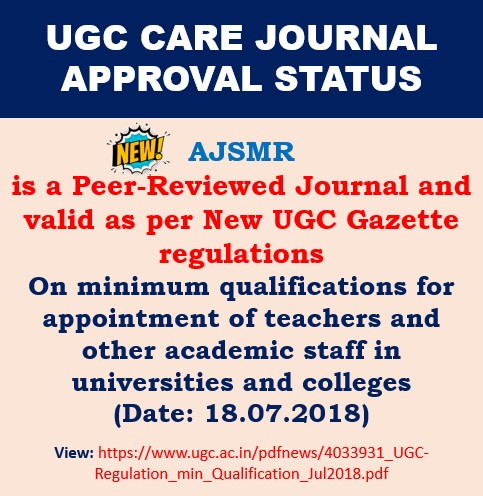Original Research Article I Volume 4 I Issue 3 I 2018
Bacteria population in Industrially Polluted Soils in Kallur, Khammam
B. Lalitha Kumari
The American Journal of Science and Medical Research 4(3) Page 24-27
DOI:http://dx.doi.org/10.17812/ajsmr436
Abstract:
In the present study on microbial and plant diversification in polluted soil system and soils were assessed.Bacteria are most numerous of the microorganisms present in the soil and form about 25% of the total microbial biomass(range 10-40%) with variable populations estimates to be 2 * 10 8 cells g -1 soil (range 10 6 to 10 9). The bacteria are nutritionally and physiologically diverse and dominant group of microorganisms in soil and their biomass is generally exceeds the fungal biomass in soil. The diversity of bacterial community in soil as revealed by using DNA re association analysis technique is as much as 170 folds greater than reveled by the bacterial isolates from soil.
Keywords:
Industry, polluted soils
References:
[1] Alexander .M; Introduction to soil microbiology, 2nd edition Wiley Eastern Ltd, New Delhi. (1961).
[2] Atlas, R.M. (1992). Petroleum Micro biology In :Encyclopedia of Microbiology, 13 : pp.363.
[3] Burns, R.G., 1983. Extra cellular enzyme-substrate interactions. In microbes in their natural environment, Slater, J.H., R. Wittenbury and J,W.T. Wimpenny (Eds.). Academic Press, Cambridge, 249-298.
[4] Chaudhary ,A.M., S.P. Mc- Grath, B.P Knigha, D.L., Jhonson and K.C. Jones., 1996. Effects of the fungicides benomyl and captan on soil ecological processes and plant growth
[5] Genovese, M., R. Denaro, S. Cappello, G. Di Macro, G. La Spada,L. Giuliano, L. Genovese and M.M. Yakimov, 2008. Bioremediation of benzene, toluene, ethylbenzene, xilenes- contaminated soil : a biopile pilot experiment. J.Appl. Microbiol., 105 : 1694-1702.
[6] Kanazawa, S., S. Asakawa and Y. Takai 1988. Effect of fertilizer and manure application on microbial numbers, biomass and enzyme activities in volcanic ash soils. Soil Sci. Plant Nutr., 34 : 429-439.
[7] Keshri, J., Mankazana, B.B., &Momba, M.N. (2014). Profile of bacterial communities in south African mine-water samples using Illumina next-generation sequencing platform. Applied Microbiology and Biotechnology, 99, 3233-3242.
[8] Kizilkaya, R. T. Askin, B.Bayrakli and M. Saglam,2008. Microbiological characteristics of soils contaminated with heavy metals. Europ. J. Soil Biol., 40, 95-102.
[9] LalithaKumari .B
[10] Lima J.A., E. Nahas and A.C. Gomes 1996.Microbail populationts and activities in sewage sludge and phosphate fertilizer-amended Soil. Appl. Soil Ecol., 4 :75-82.
Article Dates:
Received: 18 July, 2018; Accepted: 23 August, 2018; Published: 30 September, 2018
How To Cite:
http://dx.doi.org/10.17812/ajsmr436 Received :18 July, 2018 Accepted; 23 August, 2018 Available online :30September, 2018



